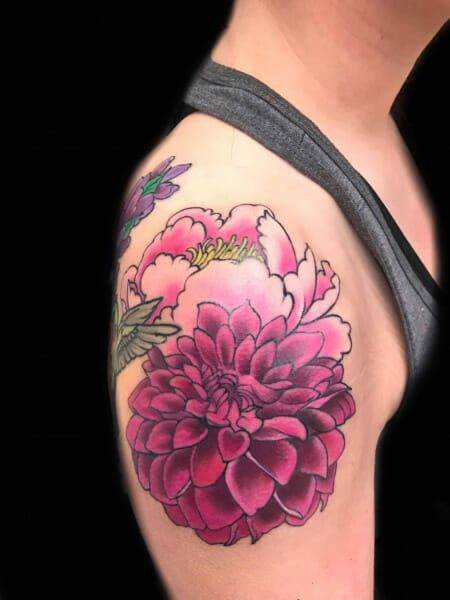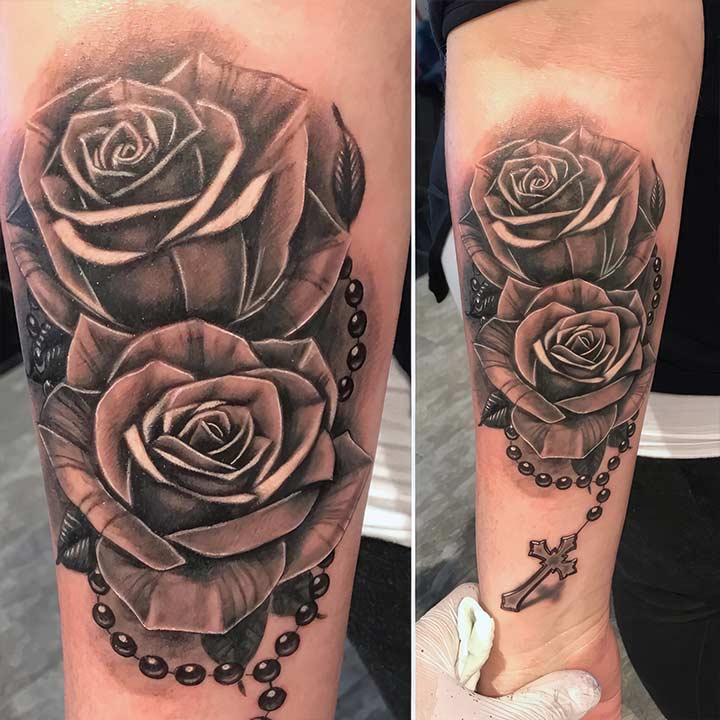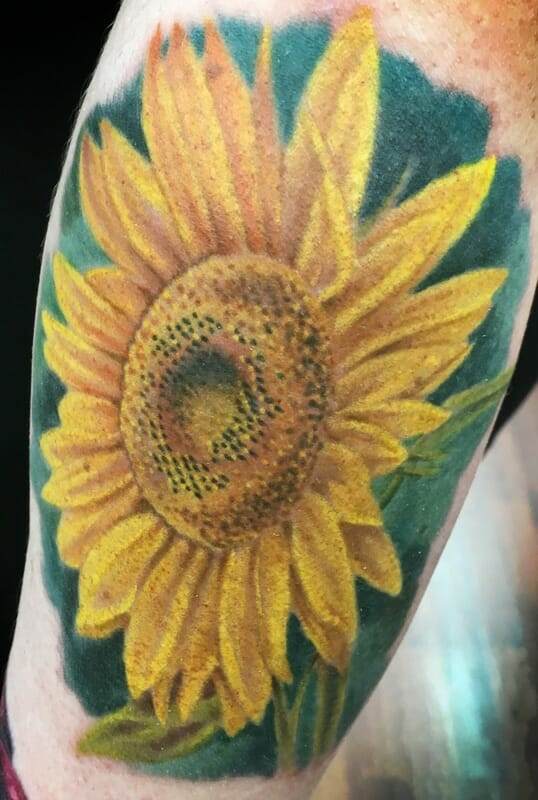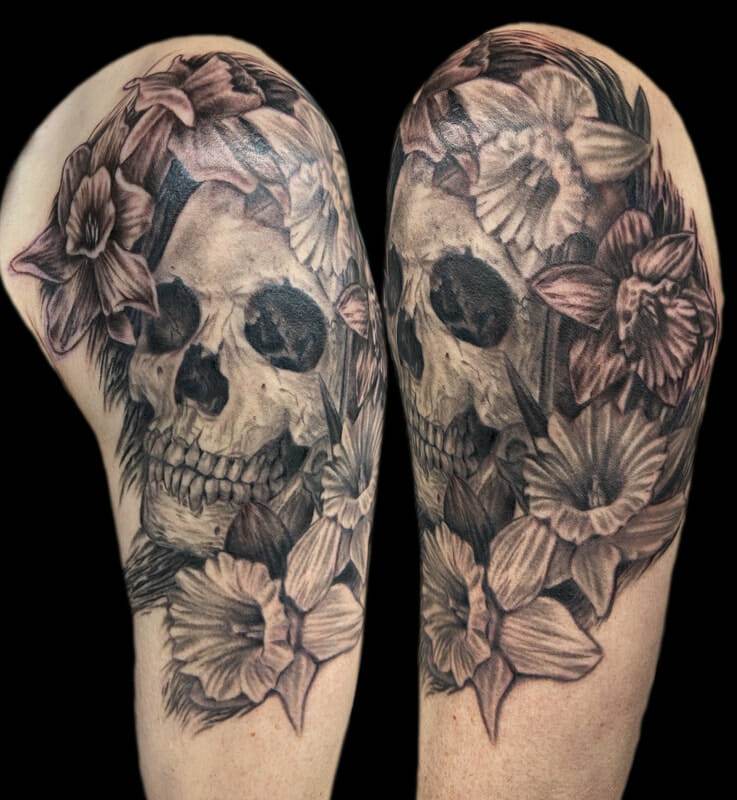Floral tattoos have become increasingly popular in recent years, with people choosing to adorn their bodies with beautiful and intricate designs of flowers. These tattoos have a rich history and hold significant meaning in various cultures around the world. In modern culture, floral tattoos have become a way for individuals to express themselves and celebrate the beauty of nature.
The history of floral tattoos can be traced back thousands of years. In ancient Egypt, floral tattoos were seen as a symbol of fertility and rebirth. The lotus flower, in particular, held great significance and was often depicted in Egyptian art and tattoos. In Japanese culture, floral tattoos have a long-standing tradition and are associated with various meanings such as beauty, strength, and femininity. Hawaiian culture also embraces floral tattoos, with the hibiscus flower being a popular choice among locals.
In today’s society, floral tattoos have gained immense popularity due to their aesthetic appeal and the personal significance they hold for individuals. These tattoos allow people to express their love for nature, commemorate loved ones, or simply add a touch of beauty to their bodies. Floral tattoos have become a form of self-expression and a way for individuals to connect with their own identity and values.
Historical Significance of Floral Tattoos in Different Cultures
A. Floral tattoos in ancient Egypt
In ancient Egypt, floral tattoos were not only seen as decorative but also held deep symbolic meaning. The lotus flower, in particular, was highly revered and often depicted in Egyptian art and tattoos. The lotus symbolized rebirth and the cycle of life, as it would close its petals at night and reopen them in the morning. This symbolism resonated with the Egyptians’ belief in the afterlife and the concept of resurrection.
B. Floral tattoos in Japanese culture
Floral tattoos have a long-standing tradition in Japanese culture and are deeply rooted in their history. Cherry blossoms, or sakura, are one of the most popular floral tattoos in Japan. These delicate flowers symbolize the transient nature of life and are associated with beauty, renewal, and the fleeting nature of existence. Cherry blossom tattoos are often chosen by individuals to represent the impermanence of life and to remind themselves to live in the present moment.
C. Floral tattoos in Hawaiian culture
In Hawaiian culture, floral tattoos hold great significance and are a way for individuals to connect with their heritage and express their love for the islands. The hibiscus flower, in particular, is a popular choice for Hawaiian tattoos. The hibiscus is a symbol of beauty and femininity and is often associated with the goddess Pele, who is believed to reside in the volcanoes of Hawaii. Hawaiian floral tattoos are a way for individuals to honor their roots and pay homage to the natural beauty of the islands.
Popular Floral Tattoo Designs and Their Meanings
A. Rose tattoos
Rose tattoos are one of the most popular floral designs and hold various meanings depending on the color and style of the tattoo. Red roses symbolize love and passion, while white roses represent purity and innocence. Yellow roses are associated with friendship and joy, while black roses can symbolize death or mourning. Rose tattoos can be done in a realistic style or with a more traditional or watercolor approach, allowing individuals to choose a design that best represents their personal meaning.
B. Lotus tattoos
Lotus tattoos are highly symbolic and hold deep spiritual meaning in many cultures. The lotus flower grows in muddy waters but emerges clean and pure, symbolizing enlightenment and spiritual awakening. In Buddhism, the lotus is associated with purity of body, speech, and mind. Lotus tattoos can be done in various colors, with each color holding its own significance. Pink lotus flowers represent purity of the heart, while blue lotus flowers symbolize wisdom and knowledge.
C. Cherry blossom tattoos
Cherry blossom tattoos are a popular choice, especially among those who appreciate the beauty and transience of life. These delicate flowers bloom for a short period of time, usually in the spring, and then fall to the ground. Cherry blossom tattoos symbolize the fleeting nature of life and remind individuals to cherish each moment. These tattoos are often done in soft pastel colors, creating a sense of delicacy and beauty.
How to Choose the Right Flower for Your Tattoo
A. Personal significance
When choosing a flower for your tattoo, it is important to consider its personal significance to you. Think about what the flower represents and how it aligns with your values or experiences. For example, if you value love and passion, a rose tattoo may be a fitting choice. If you are drawn to the idea of rebirth and renewal, a lotus flower tattoo may resonate with you. Ultimately, the flower you choose should hold personal meaning and reflect your own unique story.
B. Symbolism
Flowers have long been associated with specific meanings and symbolism. Research the symbolism behind different flowers to find one that resonates with you. For example, sunflowers are often associated with happiness and positivity, while daisies symbolize innocence and purity. By choosing a flower that holds symbolic meaning, you can add an extra layer of depth to your tattoo.
C. Aesthetic appeal
While personal significance and symbolism are important factors to consider when choosing a flower for your tattoo, aesthetic appeal should also be taken into account. Look for flowers that you find visually appealing and that will complement your body shape and existing tattoos, if applicable. Consider the size, color, and overall design of the flower to ensure it will create a visually pleasing tattoo.

The Importance of Placement in Floral Tattoos
A. Consideration of body shape
When deciding on the placement of your floral tattoo, it is important to consider your body shape. Certain flowers may look better on certain areas of the body, depending on their size and shape. For example, larger flowers with intricate details may be better suited for larger areas such as the back or thigh, while smaller flowers may be more suitable for smaller areas such as the wrist or ankle. By considering your body shape, you can ensure that the floral tattoo will enhance your natural curves and proportions.
B. Visibility
Another factor to consider when choosing the placement of your floral tattoo is its visibility. Think about whether you want the tattoo to be easily visible or if you prefer it to be more discreet. If you want to showcase your tattoo, consider placing it on an area that is often exposed, such as the forearm or shoulder. If you prefer a more hidden tattoo, choose a placement that can be easily covered by clothing, such as the upper back or thigh.
C. Personal preference
Ultimately, the placement of your floral tattoo should come down to personal preference. Choose a location that feels right for you and that you will be happy with for years to come. Take into consideration how the tattoo will age and whether it will still look appealing as you grow older. Remember that tattoos are permanent, so it is important to choose a placement that you will be comfortable with for the rest of your life.
Different Styles of Floral Tattoos: Realism, Watercolor, and Traditional
A. Realism
Realism is a popular style for floral tattoos, as it allows for intricate details and a lifelike representation of the flower. Realistic floral tattoos often feature shading and highlights to create depth and dimension. This style requires a skilled artist who can capture the delicate details of the flower and bring it to life on the skin.
B. Watercolor
Watercolor tattoos have gained popularity in recent years due to their vibrant colors and unique aesthetic. Watercolor floral tattoos often feature soft edges and blending of colors, creating a dreamy and ethereal look. This style is perfect for those who want a more abstract and artistic representation of a flower.
C. Traditional
Traditional floral tattoos are characterized by bold lines, solid colors, and a classic design. This style is often associated with old-school tattooing and has a timeless appeal. Traditional floral tattoos typically feature flowers such as roses, lilies, or daisies and are done in a bold and vibrant color palette.
The Role of Color in Floral Tattoos
A. Color symbolism
Color plays a significant role in floral tattoos, as different colors can convey different meanings and emotions. For example, red is often associated with love and passion, while yellow represents joy and happiness. Blue is often associated with tranquility and peace, while purple symbolizes royalty and spirituality. When choosing the colors for your floral tattoo, consider the emotions or qualities you want to evoke and choose colors that align with those meanings.
B. Color combinations
The combination of colors in a floral tattoo can also add depth and visual interest to the design. Consider using complementary colors, such as blue and orange or purple and yellow, to create contrast and make the tattoo stand out. Monochromatic color schemes can also be effective, using different shades of the same color to create a cohesive and harmonious look.
C. Color fading
It is important to keep in mind that over time, the colors in a floral tattoo may fade or change slightly. This is a natural part of the tattoo aging process and can be influenced by factors such as sun exposure, skincare routine, and the quality of the ink used. To minimize color fading, it is important to protect your tattoo from excessive sun exposure and to follow proper aftercare instructions.
The Healing Power of Floral Tattoos: A Personal Story
A. Explanation of the healing power of tattoos
Tattoos have long been associated with healing and transformation. For many individuals, getting a tattoo can be a cathartic experience and a way to process emotions or experiences. Tattoos can serve as a form of self-expression and a way to reclaim one’s body and identity. The act of getting a tattoo can be empowering and can provide a sense of control and ownership over one’s body.
B. Personal story of a floral tattoo’s healing power
One individual, Sarah, shares her personal story of how a floral tattoo helped her heal from a traumatic experience. After going through a difficult breakup, Sarah decided to get a tattoo of a lotus flower on her wrist. The lotus symbolized resilience and the ability to rise above adversity, which resonated deeply with Sarah. Every time she looked at her tattoo, she was reminded of her own strength and the journey she had been through. The act of getting the tattoo and having it permanently on her body served as a reminder of her own resilience and helped her heal from the pain of her past relationship.
Tips for Caring for Your Floral Tattoo
A. Proper aftercare
Proper aftercare is essential for ensuring the longevity and vibrancy of your floral tattoo. Follow your tattoo artist’s instructions for cleaning and moisturizing the tattoo in the days following the appointment. Avoid picking or scratching at the tattoo, as this can lead to scarring or color loss. Keep the tattoo clean and moisturized, and avoid exposing it to excessive sun or water until it is fully healed.
B. Avoiding sun exposure
Sun exposure can cause tattoos to fade or lose their vibrancy over time. To protect your floral tattoo from sun damage, avoid prolonged exposure to direct sunlight and always apply sunscreen with a high SPF when spending time outdoors. Consider wearing clothing that covers the tattoo if you know you will be in the sun for an extended period.
C. Touch-up appointments
Over time, tattoos may require touch-up appointments to maintain their color and clarity. The frequency of touch-ups will depend on various factors, such as the quality of the ink used, the location of the tattoo, and how well it has been cared for. Consult with your tattoo artist about when and how often touch-ups may be needed for your specific tattoo.
The Future of Floral Tattoos: Emerging Trends and Innovations
A. New techniques
As tattooing continues to evolve, new techniques are emerging that allow for even more intricate and detailed floral tattoos. Artists are constantly pushing the boundaries of what is possible with tattooing, using techniques such as microblading, stippling, and dotwork to create stunning floral designs. These new techniques allow for more realistic and unique tattoos that capture the beauty of flowers in a whole new way.
B. Innovative designs
In addition to new techniques, innovative designs are also emerging in the world of floral tattoos. Artists are experimenting with different styles, such as combining realism with watercolor or incorporating geometric elements into floral designs. These innovative designs allow individuals to create truly one-of-a-kind tattoos that reflect their own personal style and taste.
C. Future predictions
The future of floral tattoos is bright, with continued innovation and creativity expected in the coming years. As technology advances, new inks and pigments may be developed that offer even more vibrant and long-lasting colors. Additionally, advancements in tattoo removal technology may make it easier for individuals to change or modify their floral tattoos if desired.

The Beauty of Floral Tattoos: Celebrating Nature and Self-Expression
In conclusion, floral tattoos have a rich history and hold significant meaning in various cultures around the world. They have become a popular form of self-expression in modern culture, allowing individuals to celebrate the beauty of nature and connect with their own identity and values. Whether it’s a rose tattoo symbolizing love and passion or a lotus tattoo representing spiritual awakening, floral tattoos have the power to convey deep emotions and tell personal stories. The future of floral tattoos looks promising, with new techniques and designs constantly emerging. As individuals continue to seek ways to express themselves and celebrate the beauty of nature, floral tattoos will remain a timeless and meaningful choice.



